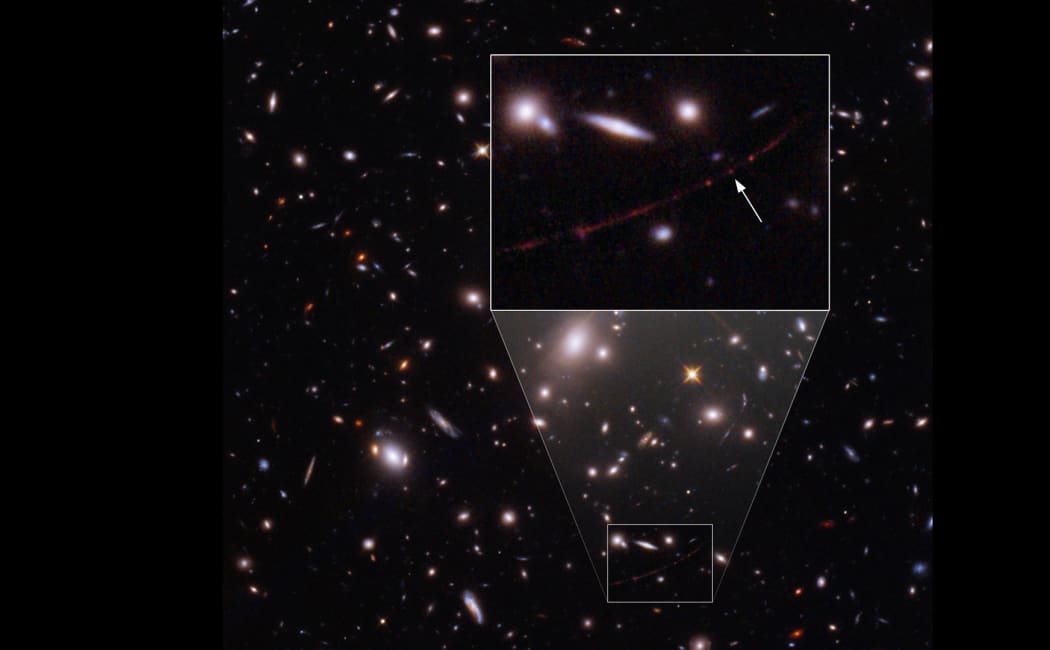ames Webb Telescope Reveals ‘Earendel’ Might Not Be a Star but a Star Cluster

James Webb Telescope Reveals ‘Earendel’ Might Not Be a Star but a Star Cluster
August 18, 2025 | By Science Desk
For years, astronomers believed that Earendel was the most distant star ever detected in the universe. Originally spotted by the Hubble Space Telescope in 2022, Earendel was thought to have formed nearly 900 million years after the Big Bang. But now, new evidence from the powerful James Webb Space Telescope (JWST) suggests that what we once celebrated as a lone star might actually be something entirely different — a cluster of stars.
What Exactly is Earendel?
The celestial body, named after the Old English word for "morning star," lies within the Sunrise Arc galaxy, visible to us only due to the effect of gravitational lensing. This cosmic magnifying glass is created when massive galaxy clusters bend and focus light from objects billions of light-years away, allowing telescopes like JWST to capture details otherwise impossible to detect.
Initially, astronomers classified Earendel as a single, massive star or perhaps a binary system. However, a new study published in The Astrophysical Journal in July 2025 challenges this assumption. Using JWST’s advanced Near-Infrared Spectrograph (NIRSpec), researchers found that the light spectrum from Earendel matches that of ancient globular star clusters, not a solitary star.
Why the Discovery Matters
If Earendel is indeed a cluster of stars, it could transform how scientists study the early universe. Globular clusters are groups of stars born from the same gas and dust clouds, tightly bound together by gravity. They are considered some of the oldest building blocks of galaxies. Finding such a cluster so far back in time gives researchers a rare glimpse into how galaxies evolved less than a billion years after the Big Bang.
Comparisons with Other Star Clusters
The research team compared Earendel’s light profile with that of another nearby cluster in the same galaxy, called 1E 0102. The similarities were striking. Both objects appeared to be 30 to 150 million years old, extremely metal-poor, and followed the same age-to-metallicity patterns observed in other ancient clusters closer to our Milky Way.
Unlike modern stars, which contain heavy elements forged in previous generations of stellar explosions, these clusters are made up of stars with almost no heavy elements. This makes them cosmic fossils that reveal the raw conditions of the early universe.
A Shift in Cosmic Understanding
NASA’s official release emphasized how significant this revelation is. The earlier classification of Earendel as a single "most distant star" captured headlines worldwide, but the possibility of it being a globular cluster could be even more groundbreaking. That’s because studying star clusters at such distances has rarely been possible before.
According to the authors of the study — Massimo Pascale, Liang Dai, Brenda L. Frye, and Aliza G. Beverage — “Earendel within the Sunrise Arc galaxy was previously identified as a candidate star or binary system due to its extreme magnification. However, new models suggest that this magnification could also apply to star clusters, not just stars.”
The Role of the James Webb Space Telescope
The James Webb Space Telescope, launched in late 2021, continues to exceed expectations. With its advanced infrared technology, JWST is capable of peering further into the cosmos than any other observatory in history. Its instruments can detect faint light from galaxies and stars formed just a few hundred million years after the Big Bang.
In Earendel’s case, JWST’s spectroscopic redshift measurements confirmed that the galaxy containing Earendel existed less than a billion years after the universe began. This makes it one of the earliest known stellar groupings — whether it turns out to be a single star or a full star cluster.
Future Research and What’s Next
The discovery raises several intriguing questions. If Earendel is indeed a star cluster, could there be many more like it hiding in the distant universe, waiting to be revealed by JWST? And what can these clusters tell us about the formation of galaxies, stars, and even planetary systems in the cosmic dawn?
Astronomers are now planning follow-up observations with JWST’s NIRCam and MIRI instruments to study Earendel and other features of the Sunrise Arc galaxy. These investigations may uncover even more surprises about the early universe’s structure and the mysterious processes that shaped it.
Conclusion
While the reclassification of Earendel might feel like a downgrade from “most distant star” to “possible star cluster,” the reality is that it opens up an entirely new frontier in astronomy. Star clusters this ancient and this far away are virtually uncharted territory. By shedding light on them, JWST is helping scientists piece together the story of our cosmic origins, one discovery at a time.
Source: The Astrophysical Journal (July 2025), NASA, ESA, CSA
